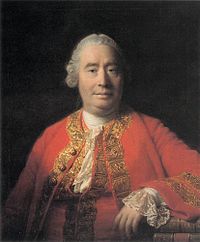According to Hume in A Treatise on Human Nature (1740), there are two types of mental activity: "impressions" and "ideas". From Hume's comments, I would describe impressions as including all mental activity that is not an idea. This would include emotions, of course, but also physical and mental perceptions that occur while interacting with the world. For example, if you touch a hot stove, you experience hotness (the impression) independently of the idea of "hot".
Impressions and ideas can be "simple" or "complex". Simple impressions and ideas cannot be broken into component parts of other impressions and ideas. Complex ones can be subdivided into simpler parts.
There is a very close association between simple impressions and ideas - so much so that they may often appear inseparable in the mind. When I touch the hot stove, I feel the hotness and think "hot" almost simultaneously.
All simple ideas are preceded and derived from simple impressions. "All our simple ideas in their first appearance are derived from simple impressions, are correspondent to them and which they exactly represent." The impression comes first, then the idea. "We cannot form to ourselves a just idea of the taste of a pine apple, without having actually tasted it."
Complex ideas, composed of simple ideas (and their related impressions), correspond closely to complex impressions. "...all simple ideas and impressions resemble each other; and as the complex are formed from them, we may affirm in general, that these two species of perception are exactly correspondent."
In general, complex ideas can be linked to preceding complex impressions, just as in the simple idea case. However, there are exceptions. Hume gives an example. Imagine you are shown a pallet of blue shades ranging from dark blue to light blue. One shade in the middle is missing. You can form an idea of what that shade looks like, even though you haven't actually seen it because you can derive the idea from the impressions of the blues on either side of the missing spot. So while there can be complex ideas not preceded by a directly corresponding impression, the idea is derived from a collection of impressions that closely resemble the idea. "Ideas produce the images of themselves in new ideas; but as the first ideas are supposed to be derived from impressions, it still remains true, that all our simple ideas proceed either mediately or immediately, from their correspondent impressions."
From my own analogy, I suggest we can form the idea of a number, say for example "152" because we have a prior impressions/ideas of 1, 2, 3 etc. I also suggest that this same process could be extended to the idea of infinity. I note that this logic seems to support Hume. While we can have the idea of infinity, it still leaves us uneasy mainly because we have never had the experience/impression of actual infinity.
Given this discussion of impressions leading to ideas, and not the reverse, Hume states that there are no innate ideas. They are all derived from our impressions. "...ideas are preceded by other more lively perceptions, from which they are derived, and which they represent."
As I was reading this chapter I kept think of the left brain / right brain theory - particularly that it would be interesting if you substituted those words into Hume's argument. I also thought about the books, Drawing from the Right Side of the Brain by Edwards and The Feeling of What Happens - Body and Emotion in the Making of Consciousness by Damasio. Finally, I felt that Hume was weighing in on the always popular party question: was mathematics invented or discovered? His comment that there are no innate ideas seems to put him in the "invented" camp. I would disagree with him on that point.
Subscribe to:
Post Comments (Atom)




No comments:
Post a Comment